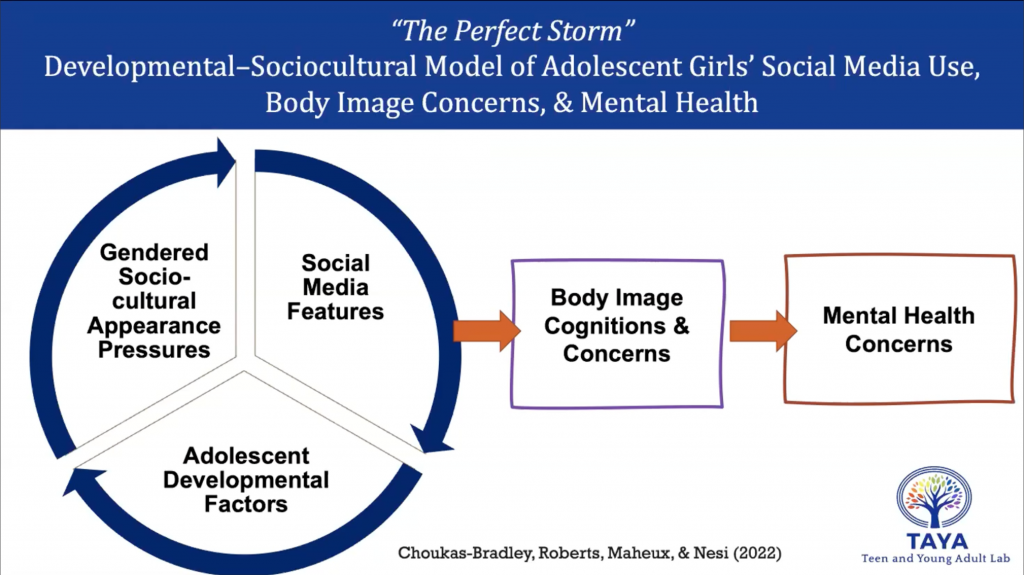
While adolescents of all genders are using online and social media platforms daily, with over half saying “constantly” (Pew Research Center, 2023), there are unique social pressures and risks that girls face in their digital lives that can significantly affect their physical and mental health.
Children and Screens convened leading researchers, psychologists and parenting experts for a webinar to help parents and caregivers understand the digital lives of girls today, build awareness of the particular risks they may face online, and provide tips to help girls navigate the increasingly tricky waters of today’s social media and digital interactions.
Media use and its risks for girls
Social media’s unique features intensify mental health impacts
Features unique to social media intensify its mental health effects on girls. According to Sophia Choukas-Bradley, PhD, Assistant Professor of Psychology, Director of the Teen and Young Adult Lab (TAYA Lab), University of Pittsburgh, “social media involves the intersection of peer influences and mass media influences” – long standing, gender-related sociocultural pressures and specific features of social media that also intersect with adolescent developmental factors to increase body image and mental health concerns for adolescent girls in particular, as well as for gender minority youth.

These features of social media work together to increase the psychological impact of social media on adolescents:
- Visualness – Photographs and videos emphasized
- Availability – Ease of access and sharing of content, regardless of physical location
- Permanence– Permanent accessibility of content shared via social media
- Publicness – Accessibility of information by large audiences
- Quantifiability – Countable social metrics such as likes, friends, and followers
- Cue Absence – Absence of physical in-person cues to communication
- Asynchronicity – Time lapse between aspects of communication
- Algorithmic – Intensification of interest-based content presentation from algorithms
Negative body image and its health impacts
“Adolescence is a time of heightened body image concerns and this is especially true for girls and transgender or gender minority youth. It’s important for parents of adolescents to be aware of the importance and centrality of body image during this developmental period,” says Sophia Choukas-Bradley. “Social media may be exacerbating these body image concerns.”
Choukas-Bradley notes the multiple possible impacts of negative body image for adolescent girls who over-focus on aligning their bodies with sociocultural beauty standards:
- Disordered weight and shape-related behaviors
- Disordered eating behaviors
- Feeling negative mood in general
- Developing depressive symptoms or even a clinical depressive disorder
- Health risk behaviors such as indoor tanning and use of skin bleaching creams
- Decreased academic motivation and engagement in STEM fields
Broader risks to self-esteem
Though negative mental health impacts from social media-induced body image problems are very real, psychologist and author Lisa Damour, PhD, urges caregivers to be aware of other more subtle harms to girls from social media use, like overfixation on perfectionism and productivity. “There’s a lot of ways this can happen,” she says, citing the popular social media trend of “that girl” memes, highlighting girls who appear extremely organized and productive, getting up early and getting things done. “On the face of things, it looks healthy and wholesome. I think it’s hard on girls,” she says. “It sets another standard of a way of having to be put together all the time. We want to keep an eye on that, because the goal of social media should be to enrich the lives of young people” and not make them feel “less than.”
Sexualized media myths
Media myths are “social constructions that have no roots in any fixed reality but have become so pervasive, so seemingly normal, so naturalized by repetition that people believe in them with the result that they have real world effects,” says Meenakshi Gigi Durham, PhD, Professor and Collegiate Scholar, University of Iowa, and author of The Lolita Effect: The Media Sexualization of Young Girls and Five Keys to Fixing It.
Durham has identified five prevalent “Media Myths of Girls’ Sexualization” that “describe sexual representation that is objectifying, degrading or sexist or otherwise inaccurate or harmful” instead of healthy, progressive, or age-appropriate.
- “If you’ve got it, flaunt it.” – Girls signaling sexuality by exposing their bodies as much as possible, including sexting, where transmitting risque messages is seen as a way to signal desire.
- “Anatomy of a sex goddess” – Admiration of “the Barbie body” – a body impossible to attain
- “Pretty babies” – “the message is increasingly that the younger a girl is the sexier she is.”
- “Violence is sexy” – seen in horror films and video games in particular, “dangerous given the high rates of sexual violence and intimate partner violence that we see across the country.”
- “What boys like matters more than what girls want and need.”
These myths “lead to increased sexual activity in many cases, lower self-esteem, negative body image, sometimes very serious consequences, eating disorders, major depression, suicidal ideation. They seem innocuous, but they’re not, and children and teens are exposed to millions of such images and messages every day,” says Durham.
Risks (and opportunities) for girls with marginalized identities
A combination of stressors, both within the self and within environments, related to minoritized or marginalized identities “can create heightened risk for a broad range of mental health concerns and risk behaviors,” says Choukas-Bradley. Experiences of gendered-racial oppression and discrimination, homophobia, and transphobia can increase the risk for mental health and body image concerns for a girl with a minority identity. ““Research across several fields indicates that girls with marginalized identities are disproportionately at risk for online victimization, and heightened social media activity might adversely impact young women’s gender socialization and diminish their well-being,” says Lanice Avery, PhD, Assistant Professor of Psychology and Women, Gender, and Sexuality Studies, Director of the Research on Intersectionality, Sexuality, and Empowerment (RISE) Lab, University of Virginia.
Avery indicated that youth of color, especially Black girls, are more likely to experience identity-based violence on social media than their race and gender counterparts. She identified several domains of well-being that may be impacted by frequent media engagement, including:
- Greater endorsement of unattainable feminine beauty and body ideals
- Diminished self-esteem and increased body shame
- Greater levels of depression, anxiety, sensitivity, and hostility
- Diminished self-care behaviors and greater drug and alcohol use for coping
- Internalization of disempowering and inauthentic romantic relationship beliefs and behaviors
Yet the risks of social media exposure are also accompanied by unique opportunities for community-building and resource-finding. For young Black women, Avery notes what she calls a “paradox” of social media use. “These sites offer Black women an opportunity to produce and consume empowering messages that challenge those rooted in structural racism. But they also heighten their exposure to gendered racism and sexual victimization in the process.”
Tips for Parents and Caregivers
Demonstrate manipulation
“Today’s algorithms drag kids down rabbit holes,” says Damour. With one search for diet or before/after body images, or even makeup routines, teens are subsequently flooded with similar content. “This is very dangerous,” she says. “Talk to teenagers about them. Tell them they are being played by social media outlets, that their attention is being manipulated for money. Teenagers do not like to be manipulated and they will change their behavior when they understand they’re being manipulated.”
Choukas-Bradley concurs. “Adolescents really do not like to know that they’re being manipulated by ‘the man,’ they really value autonomy and independent decision making,” she says. Having conversations about the ways that algorithms are developed and the specific things that technology leaders have said about capturing teen attention can help drive awareness and change in adolescent online behavior.
Start early with critical thinking
Reflection on media use is not just for adolescents – introducing a critical-thinking approach for younger children will serve them well as they age with their media use, says Durham.
“Introduce a critical consciousness fairly early,” she says. “With my own kids, like when they were very little, we’d see an ad for sugary cereal for example. And I’d say, ‘Hey, they’re telling us this sugary cereal is part of a healthy breakfast. What do you think about that?’”
Model a healthy relationship to technology and your own self- esteem
Let’s face it – adolescents know when you’re not practicing what you preach. Damour urges parents and caregivers “Don’t talk about it. Be about it. With your little kids and with your teenagers, you’ve got to model what you say you want them to be doing.” What does this mean particularly for young girls? Keeping your technology out of your own bedroom, refraining from talking about your own appearance and weight, and thinking very carefully about the relationship with technology and your own relationship with yourself and your own self-esteem. Your child is watching and learning from what you do more than what you say.
Recognize the limits of awareness
While it’s important to build awareness of how online media affects girls’ body image and mental health negatively, this awareness itself does not erase the impacts from exposure to media completely, warns Choukas-Bradley. She cites research showing that even when adult women, with fully-developed brains and decades of experience looking at media images, are fully, cognitively aware that an image has been digitally altered, and is not real, exposure to those mass media images still leads immediately to poorer body image.
Build self-esteem by valuing nonvisual characteristics
The more comments and praise a girl hears about her external characteristics, the more value she will place on these characteristics over other traits, says Damour. “We have to be very mindful as the adults in kids’ environments, how we talk about their ‘containers’ versus how we talk about their ‘content,” she says. “Every moment that we are talking about what a kid looks like, we are not talking about who she is inside. I’m not saying you can’t tell your daughters they’re cute. I love telling my daughters they’re cute. We also have to spend a lot of time talking about how smart, interesting, funny, sardonic and all of that they are.”
Keep screens out of bedrooms
Any discussion about adolescent health and digital media should involve removing technology from bedrooms, says Damour. “I do not think any technology should be in any bedrooms ever for anyone, if possible. …. but for no other reason than just to protect sleep. When we see negative mental health outcomes as a function of technology, so often it is through the pathway of disrupted sleep.”
Introduce new technology slowly
“Hold off as long as you can on devices with browsers and apps” that can be accessed 24/7, says Damour. It’s possible to find smartphones with no browsers and apps that can be used as a “walkie talkie text machine” that allows them to communicate with friends without full access to platforms and algorithms. “You really can move slowly” before allowing that access, she says. (See the “Smartphones: Assessing Readiness” tip sheet for more on how families can determine whether a child is “ready” for a smartphone.)
Prioritize offscreen alternatives
Narrowing the time girls can spend on social media platforms by filling their time with other activities is an important way caregivers can avoid the risks from exposure to the platform feeds, says Damour. “It is not so much being ‘against’ technology – that just doesn’t work – but being ‘for’ other things,” she says. “Keep kids busy. When they’re busy they just have less time online and that’s a good thing.” Being “busy” doesn’t necessarily mean more organized activities, but such things as being active in promoting healthy sleep, studying without digital interruption, physical activity, helping in the family home and in the community, and face-to-face social interactions.
Understand the power of girl friendships
“The intensity of the relationships between girls is quite different from the intensity of the relationships between boys,” says cyberbullying expert Elizabeth Englander, PhD, Executive Director and Founder, Massachusetts Aggression Reduction Center and Professor of Psychology at Bridgewater State University. “Girls tend to have strong, supportive relationships with other girls. They tend to be more invested in these relationships. To some extent that lends itself to social problems as well, because then social problems like cyberbullying tend to be more intense as well.”
Englander shares that the strongest protection against cyberbullying and the most effective way for girls to develop resilience to cope with it is peer support, to a significant extent more than boys. However, this can be a double-edged sword, she cautions. “On the one hand, the intensity of the relationships may mean that they spill over into problems like cyberbullying more often. It also means that [girls] benefit more and become more resilient when they have the support of their peers.”
Prioritize curious conversation over judgmental comments
Building awareness and understanding in teens about how media may be affecting their health means keeping lines of communication open. “Listen to your children, express your own feelings, but don’t be judgmental,” says Durham. “If you need to regulate their media, and I do think that’s important sometimes, especially for younger children, explain why you’re doing it, be reasonable, be loving, because lecturing kids never works, even though we all do it sometimes.”
You may be surprised by how your girl may already be thinking deeply about the same issues you are, saysDurham. “I have found in my dealings with young girls that the minute you sort of open that door, the minute you give them a chance, they’re amazingly critical. They engage, they’ve been thinking about this.”
Damour advocates for a curiosity-first approach for opening conversations aimed at making behavior changes. “We are talking about teenagers – top-down approaches do not work. It is really important to say ‘What does it feel like for you when you’re on this app and that app?’ I had a fantastic teenage girl say to me the other day, ‘I love my phone and I hate my phone.’ And then we could have the conversation. ‘What do you love? What do you hate? What do you wish you would do differently? What might make a difference?’ Do it from their point of view, be curious.” (See also the Motivational/Values Exercise from Choukas-Bradley at the bottom of this tip sheet.)
Be honest about your own media use struggles
“One way to start the conversation can be for adults to reflect openly a bit on their own social media use,” says Damour. “Say ‘I went on insta today and I was looking for a good time and I ended up in a terrible mood because this happened,” she says.
Modeling thoughtful reflection on how time on social media makes you feel can help a girl start her own self-investigation. “Embrace your own shortcomings,” says Damour. “Point out that on social media and 2D environments, people very rarely talk about their shortcomings. Talking about those kinds of things can help to work against perfectionism.”
Help them find social support
Coaching and helping girls find social support with peers and friends, and demonstrating to them that when they harness that support, social problems feel less significant and devastating, is extremely important, says Englander. “The world is not all puppies and rainbows. The goal has got to be to really bolster resiliency and self-confidence among girls,” she says.
Utilize respected older peers
The “best bet” for behavior change around digital media use may not be parental conversations but finding a respected older peer such as a sister, a cousin, or an old babysitter to talk with a younger adolescent about social media use, says Damour. “Somebody who can talk about their insights about what works, what doesn’t, what she regrets, what she has started to do instead in terms of her social media behavior, the chances of behavior change are way, way better than any conversation that anybody over the age of 24 is going to have with your kid,” say Damour.
These conversations benefit the older girl as well. “We know from research that often when older adolescents are asked to teach younger adolescents about anything, the behavior of the older adolescent changes for good as well, that as soon as you teach something, you actually adopt more thoroughly that value system,” says Damour.
Choukas-Bradley provides a motivational interviewing/values exercise grounded in evidence-based values approaches to psychological interventions to help parents and caregivers have productive and thoughtful conversations with their child about their digital media use:
- Have your adolescent write down a list of all the activities they do related to social media in a typical week. The goals are to figure out all the ways they are spending their time on the platforms.
- Review the list together with your child and help them sort the activities into categories:
- Those that give lasting happiness, not just a quick dopamine hit from “likes”
- Those that are fun in the moment but do not give a sense of lasting happiness (usually those that get a lot of quick likes)
- Those that cause the most stress
- Those that the child engages in the most/spends the most time on
Many times by the end of the exercise, most adolescents (and adults) realize that they are often using social media in ways that are fun in the moment but that cause stress and don’t give lasting happiness, says Choukas-Bradley.








